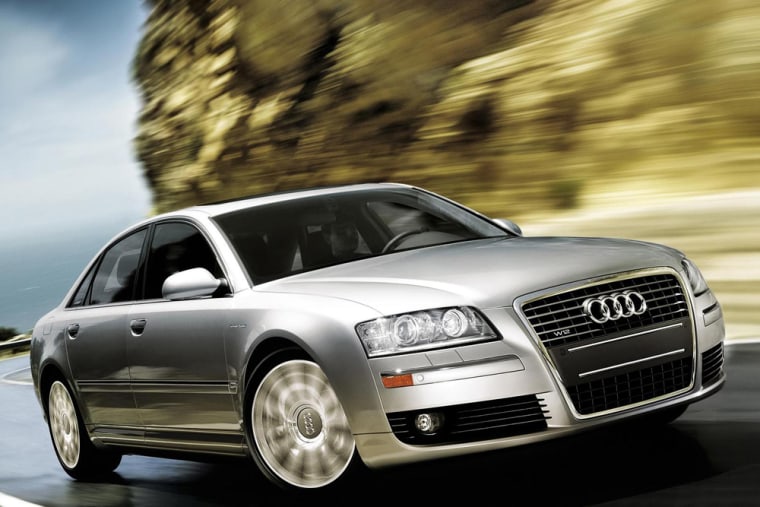Insurance companies set their rates according to how much they expect to shell out if you should wreck your car. They also factor in the probability that you actually will wreck your car, based on the composite histories of people who own the same model. These Top 10 Most Expensive Vehicles to Insure are pricey ones to begin with. On top of that, they possess idiosyncrasies that can contribute to higher repair costs, or increase the odds that repairs will one day be needed.
High-performance models made for athletic, aggressive driving are more likely to tempt you to make risky maneuvers. Powerful engines entice you to drive faster, which not only increases the likelihood of accidents but also can increase the severity of damage if you do encounter an unavoidable obstacle.
Other idiosyncrasies drive up the cost of repairs after you encounter such an obstacle. Lightweight materials like aluminum can cost more to straighten than plain, old steel. Sport suspensions and brakes can require more time in the shop to repair. They can demand more skill from technicians and call for expensive replacement parts. The same applies to exotic engines; complicated mechanisms like, say, retractable hardtops; and to sophisticated electronic systems, such as adaptive suspensions. Even the location of such systems can be a factor.
For example, the expensive radar sensors used by adaptive cruise control are typically hidden in the front end, where they're particularly prone to damage even in minor dust-ups.
“Some vehicles are just more difficult to repair,” said Mike Siemienas, spokesperson for Allstate Insurance Co. “Exotic metals can drive up the cost, because of repairability. And as the electronics become fancier, they can also have an impact.”
Our list was compiled from ratings published by the Insurance Services Office (ISO). We arranged the cars from the highest manufacturer's suggested retail price to the lowest. All cars and prices referenced in this list are for 2006 model year vehicles.
The information was provided by Dave Dasgupta, ISO's public information officer. He selected current vehicles that receive the highest risk rating for damage assigned by ISO as of autumn 2006 (the service updates the rankings regularly, as vehicle histories change). These 10 cars and SUVs receive a risk rating of 27 on a scale of one to 27.
Also called the Vehicle Symbol Rating, a rank of 27 is applied to all new vehicles that list for $80,000 or more, Dasgupta explains. That makes them equal insurance hazards, according to ISO's methodology.
“The rating symbols are advisory in nature, giving an indication of cost to repair based on the MSRP by make and model,” Dasgupta said. From there, individual underwriters assign their own rates. “Individual companies do their own due diligence, looking into the history of the car as part of their underwriting process,” he said.
Therefore, savvy consumers comparison-shop among insurers.
“Different companies determine different factors that influence the vehicle's insurance rate,” said Chante Jefferson, spokeswoman for the online insurance company Progressive Direct. “At Progressive, the rate is based on the experience of the specific vehicle, influenced by characteristics that include model year, MSRP, weight, size of the vehicle, horsepower and manufacturer of the vehicle.”
This ranking applies only to the physical-damage portion of a policy. The price of personal-injury protection is computed separately, but according to Kim Hazelbaker, senior vice president of the Highway Loss Data Institute (HLDI), physical damage is the major component of a new-vehicle policy. Other factors also affect your individual insurance premium, especially the area in which you live and work and your personal driving record. A comparison of the relative insurance losses of all cars — a good indication of their relative insurance rates — is available in the report “Injury, Collision and Theft Losses by Make and Model” on HLDI's website.
The list (see slide show link above) shows that insurance rates are granular: They break down into particular versions of vehicles.
For example, a 50-year-old husband and wife who own a home in Washington, D.C., have clean driving records and finance a basic 2006 Porsche Cayenne will pay $1,138 annually for the recommended policy from Progressive.com. But if the '06 Cayenne is the turbocharged version, the couple's annual premium jumps to $1,750.
Besides the model you buy, other fixed factors help determine your personal insurance rate, including your age, gender and the location of your home. To help keep your rate reasonable, advises Allstate's Mike Siemienas, “be a good driver: Don't get moving violations, don't get into accidents and have a safe driving record.”
“First and foremost, shop around for the best combination of price, coverages and services,” recommended Jefferson of Progressive. “Keep a clean driving record, avoid lapses in coverage, don't carry excess coverage and manage your credit.”
